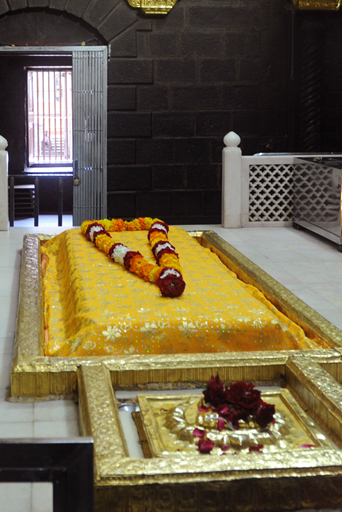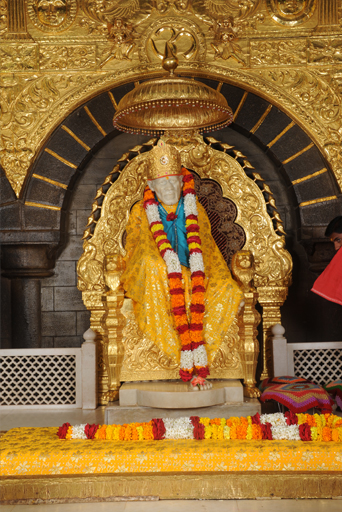Samadhi Mandir
Baba has promised, “I shall be active and vigorous even from the tomb,” and it is perhaps in the Mandir that we can most fully experience the phenomenon of Sai Baba and the remarkable way he has touched the hearts and lives of millions of people from all over the globe.Baba’s omniscient presence is felt when one has Baba’s glance, when one sits at Baba’s feet.
Ardent Devotion
At any given point, the shrine temple is full of devotees eagerly queuing up to have Baba’s darshan. People carry flowers, garlands, sweets, or fruit to offer Baba at his Samadhi. Some may have personal items- such as a shawl, book, key to new possession, etc, for which they want to get Baba’s blessing by offering it at his feet and having it touch his tomb.
“Sri Satchidananda Sadguru Sainath Maharaj ki Jai !” (Hail the great Sadguru, Lord Sai, who is being-consciousness-bliss!) is the chant on the lips of most of His devotees while most others may sing bhajan or whisper prayers.
At busy times, especially during festivals, the queue for darshan used to stretch for hundreds of meters along the village streets, though the recently constructed Queue Complex has changed this. People may wait up to eight hours just for the opportunity to pay brief homage to their Lord. The atmosphere of fervent and one-pointed devotion reaches its zenith here. “Attention one and all!” commands the noon arati psalm, “Come, come quickly and make obeisance to Sai Baba!” This is exactly what the devotees are hastening to do, and to be part of this torrent of emotion is a powerful experience.
In this form, thousands of people a day are able to take Baba’s darshan and pay their homage to Him.
Origins of the Samadhi Mandir
The shrine which houses Baba’s tomb was originally constructed as a wada (large private house) during Baba’s last years in his physical body. It is built on some land that Baba had tended as a garden. Sai Baba seemed to like growing plants and in his early days he cleared and levelled this land, which had been used as dumping ground. Using seeds that he had brought from Rahata, he planted it with jasmine and marigold. For about three years Baba would water the plants every day and distribute the flowers to the local temples. Now that his tomb is here and Baba is receiving so many devotees, it seems that he is nurturing plants of a different nature – and still sowing seeds.

The shrine was built by a wealthy devotee from Nagpur, Gopalrao Booty. The Sri Sai Satcharitra describes him as a “multimillionaire”. He was introduced to Baba by S. B. Dhumal about ten years before Baba’s Mahasamadhi.
The wada was originally intended as a rest house and mandir. The inspiration for the building came to Booty in a dream, when he was sleeping beside his friend and fellow devotee, Shama, Baba appeared and told him to build a house and temple.
Excited by his vision, Booty immediately woke up and pondered its significance. He noticed that Shama had tears in his eyes and asked him what the matter was. It transpired that Shama had just had the same dream and was deeply touched by it. He told Booty, Baba came near me and said distinctly, “Let there be a wada with a temple so that I can satisfy the desires of all.” Together then they drew up some rough sketches, showed them to Dixit for approval, then took them straightaway to Baba to ask his permission to go ahead with the plan. Baba responded warmly and gave his blessing to the project.
The work was begun around 1915. It was built in stone and was therefore known as dagadi (stone) wada. Shama supervised the construction of the basement, ground floor and well. Later, Bapusaheb took over job of supervising the work.
When Baba passed the site on his way to Lendi, he would sometimes offer suggestions. As the building progressed, Booty asked Baba if he could include a temple on the ground floor with an statue of Murlidhar (a form of Lord Krishna). Baba readily gave permission, and said, “When the temple is built, we shall inhabit it and ever afterwards live in joy.” Shama then asked Baba if that was an auspicious time to start the work and Baba replied that it was. Shama immediately fetched and broke a coconut as Mahurat (good omen) and the work was begun. The foundation was quickly laid, a pedestal prepared and an order placed for the idol. However, the significance of Baba’s comment was appreciated a few years later.
Baba’s unforeseen moving-in
It was around this time that Baba fell ill and his devotees feared the worst. Booty also felt dejected, wondering whether Baba would live to even see the completed wada, never mind grace it with his presence. The whole construction seemed pointless to him if Baba was not going to remain there in his body. However, Baba was to move into the wada in a way that had not been foreseen by others. His health rapidly deteriorated and on 15 October 1918 he lay with his body fading fast. His last words were ,”I am not feeling well in the masjid. Carry me to the dagadi wada”.
Baba was indeed carried to the wada, and was buried in the place where the image of Murlidhar was to have been placed: an edifice was later raised over the tomb.
Baba’s Mahasamadhi
The day that Baba took Mahasamadhi, Tuesday 15 October 1918, was a very auspicious one for Hindus ; it also happened to be the Muslim month of Ramzan. October 15 was the Hindu festival of holy Vijayadasami, a few minutes into ekadasi (a significant lunar cycle in the Hindu calendar). Two months previously Baba had sent a message to Banne Mia fakir, saying that “On the ninth day, of the ninth month, Allah is taking away the lamp he lit”. He also sent some offerings to the fakir Shamsuddin Mia and a request to do moulu, qawals (both are types of devotional singing) and nyas (poor –feeding). Thus right up until his final moments in the body, Baba was embracing both communities.
The news of Baba’s passing spread quickly, and thousands came to Dwarkamai for a final darshan, queuing for five or six hours. The body was kept on the handcart all night, while preparations – digging a pit and building the platform – went on. Before the burial, Baba’s kafni was removed and he was given a final bath. It is reported that even at this stage, his body remained soft, as if he were merely sleeping, Earlier, while the body was in the wheel chair, his nose started to bleed (usually impossible for a corpse).
Thirty-six hours after he had left his body, Baba was finally interred. Certain personal articles were buried with him: the broken brick, now mended with gold and silver wire, one of his satkas, a chillim, needle and cotton (Baba would mend his clothes until they were a mass of repairs, a cause of affectionate amusement among close devotees), some spices to preserve the body, and an old cloth bag that Baba never allowed anyone to touch, but which devotees investigated after his mahasamadhi and found that it contained a green kafni and a cap.
The burial was completed by very early Thursday morning. A photograph of Sai Baba was placed on a throne on the platform of the tomb. It remained there until the statue was installed in 1954. That picture is now kept in the recess of the Samadhi Mandir where some other things of Baba’s are on display (see below).

